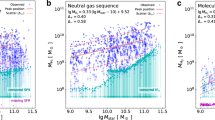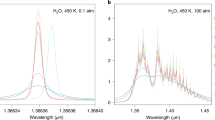Abstract
IN recent years evidence has been brought forward by several investigators1 indicating that light from distant stars suffers a slight attenuation in travelling through interstellar space. In particular a recent investigation by Jones2 assigns fairly definite numerical values to coefficients of attenuation corresponding to “photographic” and “visual” light from stars of known proper motions and spectral types the magnitudes of which had been carefully measured by Parkhurst3 for light of these wave-lengths. If, as seems reasonable, this extinction is assumed to be due to attenuation by scattering in travelling through a “residual” gas occupying, interstellar space, we are enabled to estimate the average density of molecules in the intervening regions, following a method due originally to Larmor4 for assigning an upper limit to the density of matter in comets' tails.
This is a preview of subscription content, access via your institution
Access options
Subscribe to this journal
Receive 51 print issues and online access
$199.00 per year
only $3.90 per issue
Buy this article
- Purchase on SpringerLink
- Instant access to full article PDF
Prices may be subject to local taxes which are calculated during checkout
Similar content being viewed by others
References
Kapteyn, J. C., Astrophysical Journal, xxix. (1909), pp. 46 54: xxx. (1909), pp. 284 317 and correction p. 308. Turner, H. H., Monthly Notices Roy. Ast. Soc., lxix. (1908), p. 61. King, E. S., Harvard Annals, lix., No. 6, p. 179, April, 1911; Harvard Annals, lxxvi., No. 1, pp. 1 10. 1913. Brown, F. G., Monthly Notices, lxxii. (1912), p. 195, also p. 718.
Jones, H. S., Monthly Notices Roy. Ast. Soc, lxxv (1914), pp. 4 16.
Parkhurst, J. A.,Yerkes Actinometry,Astrophysical Journal, xxxvi. (1912), p. 169.
Sir Larmor, J., Lectures, Cambridge, 1908.
Schuster, A., NATURE July 22, 1909;Optics,2nd Edition, 1909, P. 329.
King, L. V., Phil. Trans. Roy. Soc., ccxii.A (1912), pp. 375 433.
Kine, L. V., NATURE, xciii. (july 30, 1914), pp. 557 559.
Fowle, F. F., Astrophysical Journal, xl. (December, 1914), pp. 435 442.
Jones' determination is in fair agreement with Kapteyn's final result, (Astrophysical Journal, vol. xxx, p. 398): [(photographic)-(visual)] losses = +0m0031 â 0.0006. The corresponding determinations by King (E. S.) of the coefficients of attenuation for photographic and visual light give values about five times that of the text.
The losses + 0m0080 and +0mc033 estimated by Jones forPhoto-graphicandvisuallight lead to the values K1δ = 0.0073 and K2δ = 0.0030 (wive-lengths not stated). Kapteyn's (corrected) estimate for wavelength λ1 = 0.431ⵠis Kjδ = 0.00507, leading to the value n = 0.068 - 105 hydrogen molecules per cm.3, which is of the same order of magnitude as the determination already made. E. S. King's results (footnote 1) increase the estimate of the text about five-fold.
Note a discussion on this point by H. C. Plummer in a paper by H. H. Turner, loc. cit. (footnote 1).
Abbot, C. G., Astronomical Journal, xxvii. (1911), p. 20;Annals of the Smithsonian Astrophysical Observatory,vol. iii. (1913), pp. 203 210.
Kine, L. V., footnote (6), p. 379, equation (14).
King, L. V., footnote (7).
On the recent history of this comet see a paper by Backlund,Encke's Comet, 18051908,Monthly Notices, lxx. (1910), pp. 429 442.
See, T. J. J.,Researches on the Evolution of the Stellar System,1910, vol. ii., pp. 134 158.
Henkel, F. W., in an articleNebuleuses et Essaims,ScientiÅ, vol. xv. (1914), pp. 294 307.
The total number of molecules per cm.3 corresponding to the vapour-pressure of mercury at the temperature of liquid air is estimated at 3 - 107 ( Dunoyer, M. L.,Les Gaz ultra-rarefies,in the collectionLes Ides Modernes sur la Constitution de la Matire,Paris, Gauthier-Villars, 1913. p. 216).
Eddington, A. S.,Stellar Movements and the Structure of the Universe.Macnnllan and Co., Ltd., 1914, p. 255.
Lindemann, F. A.,Note on the Number of Dark Stars,Monthly Notices, lxxv. (1915).
On this point note a remark by Eddinton, loc. cit., p. 258.
Author information
Authors and Affiliations
Rights and permissions
About this article
Cite this article
KING, L. The Density of Molecules in Interstellar Space. Nature 95, 701–703 (1915). https://doi.org/10.1038/095701b0
Issue date:
DOI: https://doi.org/10.1038/095701b0



